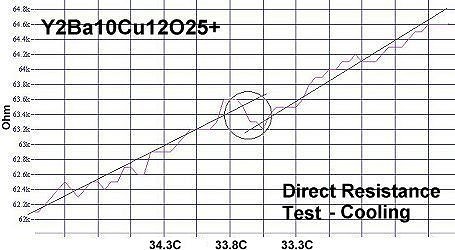
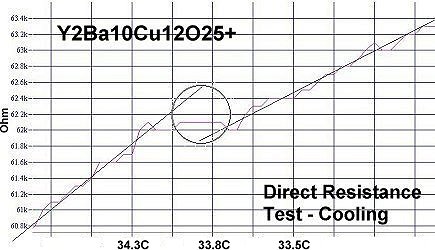


Superconductors.ORG herein reports the successful reformulation of YBCO to achieve room-temperature superconductivity. To accomplish this the chemical formula was altered from YBa2Cu3O7+ to Y2Ba10Cu12O25+ (or Y2AC using hexavigesimal notation). Its H212C target structure has a unit cell 4 times as long as standard YBCO (see graphic below left). This is the 33rd room-temperature superconductor discovered to date.[1]
With a Tc near 91K, YBCO (Y123) was the first true "high temperature" superconductor discovered in 1987. It's name is an acronym representing the constituent elements yttrium, barium, copper and oxygen. Over the years YBCO has remained the most popular HTS material, due to its low toxicity and low cost to manufacture. Although YBCO has been reformulated and improved many times, this is the first time room-temperature superconductivity has been attained using just these 4 elements.

|
At page top are two direct resistance tests showing a sudden drop in resistance near 34 Celsius (93F/307K). Though the volume fraction is low, the transitions are unambiguous and appeared consistently at the same temperature.[2] Below are two magnetization tests showing Meissner transitions of around 10 milligauss that confirm superconductivity. Having a copper-chain structure, Y2AC is multi-phasic. So the strongest transitions were deemed to be the stoichiometric phase. The signals were noisy due to the low volume fraction and high thermal noise figure inherent to these temperatures. 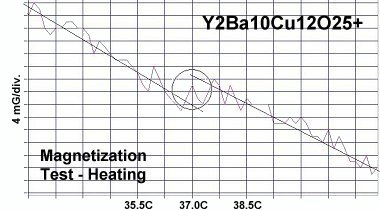
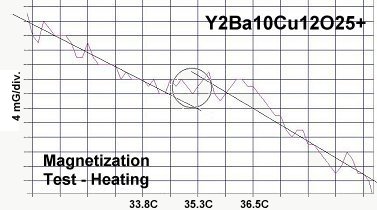
Previously most room-temperature copper-oxide superconductors required a single +4 or +5 element in the anion. However, in this discovery a +3 rare earth is used. This results in a shortage of free electrons, requiring twice as many yttrium atoms to become superconductive. Since 2005 the scientific community has failed to recognize the profound contribution planar weight disparity (PWD) makes in promoting Tc. With this discovery the Tc of standard YBCO has been increased by more than 200 degrees by simply raising the planar weight ratio along the C axis. The challenge now is to increase the volume fraction through refinement or a new synthesis technology to facilitate mass production. |
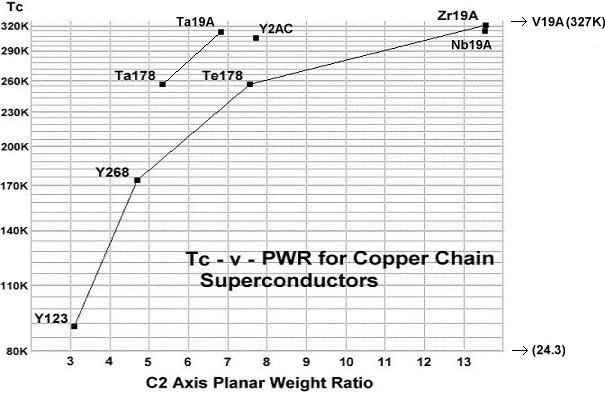
The above graph shows where Y2AC fits on the Tc-v-PWR plot for copper-chain superconductors. The lower curve represents compounds with a dielectric constant (K) near e1. And the upper line is for compounds with a Kappa near e2. This suggests Y2AC has an anion Kappa midway between 10 and 100.
In order to maximize formation of the H212C structure, this compound was synthesized using the layer cake method, as shown below. The pellet had approximately 100 interference layers. And, even using this layering technique, the volume fraction is low, requiring very sensitive test equipment.
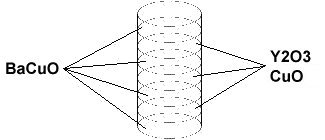
Stoichiometric ratios of the below chemicals were used for the ODD layers:
BaCuO 99.9% (Alfa Aesar) 15.27 grains...and the below for the EVEN layers.
Y2O3 99.99% (Alfa Aesar) 1.59 grainsThe chemical precursors were pelletized at 60,000 PSI and then sintered for 10 hours at 880C. Lastly the pellet was annealed for 10+ hours at 500C in flowing O2. Temperature was determined using an Omega type "T" thermocouple and precision OP77 DC amplifier. The magnetometer employed twin Honeywell SS94A1F Hall-effect sensors with a tandem sensitivity of 50 mv/Gauss.
RESEARCH NOTE: The copper-oxides are strongly hygroscopic. All tests should be performed immediately after annealing.
RE-PUBLICATION NOTICE: Elsevier Publishing, dba Elsevier Science, as well as Morris Communications, both print and broadcast divisions, are specifically prohibited from re-publishing any part of this news story.
E. Joe Eck
© 2015 Superconductors.ORG
All rights reserved.
1. For a list of all 33 room-temperature superconductors, click HERE
2. Testing temperatures are believed accurate within ± 0.5 degrees C.
 BACK to "News" page at Superconductors.ORG
BACK to "News" page at Superconductors.ORG